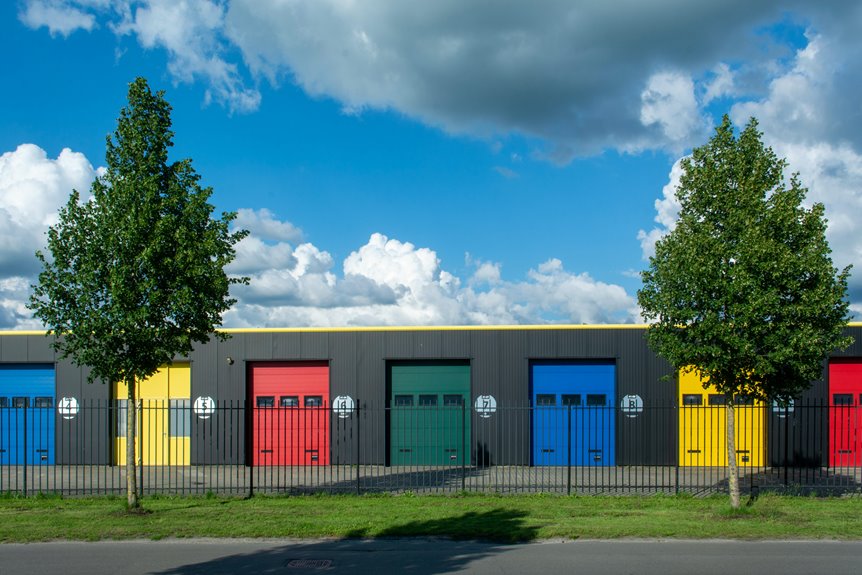As I stand before the diverse landscape of commercial properties, each one symbolizing a different avenue for potential investment, I am reminded of the intricate tapestry that makes up the real estate market. From the bustling retail spaces to the sleek office buildings, the robust industrial complexes to the inviting hospitality establishments, each property type holds its own secrets waiting to be uncovered.
Understanding these nuances is not just about recognizing the physical structures but also about deciphering the hidden opportunities that lie within. Let’s explore the world of commercial properties together and unravel the mysteries that could lead to lucrative ventures.
Key Takeaways
- Location significantly impacts success and value.
- Income opportunities through tenant rentals.
- Market trends and consumer behavior analysis.
- Understanding target market preferences crucial.
- Thorough research essential before investing.
Retail Properties
Let’s explore the world of retail properties and examine their unique characteristics and investment potentials. Retail properties are commercial real estate spaces where businesses sell products or services directly to consumers. These properties can range from single shops in a strip mall to large shopping centers with multiple stores.
One key characteristic of retail properties is their location. Being situated in high-traffic areas or areas with high population density can greatly impact their success and value.
Investing in retail properties can offer various opportunities for generating income, such as through rental payments from tenants. However, it’s important to take into account factors like market trends, consumer behavior, and competition when evaluating the investment potential of a retail property.
Additionally, understanding the specific needs and preferences of the target market in a particular location is essential for success in this type of investment. Overall, retail properties can be a profitable investment option for those willing to conduct thorough research and analysis before making any decisions.
Curious about the best fit for your investment strategy? Learn about the various types of commercial properties and how they can impact your portfolio. If you’re looking to sell, Cash4Houses provides quick and straightforward cash offers for commercial properties. Contact us now for your cash offer and simplify the selling process!
Office Spaces
When it comes to office spaces, it’s important to evaluate the layout to maximize efficiency and collaboration among employees.
The location of an office can greatly impact productivity, making it essential to choose wisely.
Additionally, integrating the latest technology into offices can streamline operations and enhance overall performance.
Office Layout Considerations
I often consider the layout of office spaces to maximize efficiency and productivity. When designing an office layout, several key factors come into play to guarantee a conducive work environment:
- Open vs. Closed Spaces: The choice between open floor plans and closed offices can impact collaboration and privacy. Finding the right balance is essential.
- Natural Light and Ventilation: Access to natural light and fresh air can boost mood and energy levels among employees, leading to increased productivity.
- Flexible Work Areas: Incorporating flexible workspaces allows for different work styles and promotes creativity and innovation within teams.
- Amenities and Common Areas: Providing amenities like break rooms, lounges, and meeting spaces can enhance employee satisfaction and overall well-being, contributing to a more productive workforce.
Considering these factors when planning an office layout can lead to a more efficient and productive work environment, ultimately benefiting both employees and the business as a whole.
Location Impact on Productivity
Considering the geographical location of an office space greatly influences the productivity levels of employees. Commuting time and ease of access play a significant role in determining how efficiently employees can get to work. A centrally located office with good transportation links can reduce stress for employees, allowing them to arrive at work fresh and ready to tackle the day.
Additionally, the surroundings of an office can impact productivity. A location with amenities such as cafes, gyms, or parks nearby can provide employees with convenient options for breaks and relaxation, leading to increased productivity during work hours. On the other hand, noisy or high-traffic locations can be distracting and hinder concentration.
Moreover, the safety and security of the area where the office is situated are essential factors. Employees need to feel safe both during their commute and while working in the office. A secure location can contribute to a more comfortable and focused work environment, positively impacting productivity levels.
Technology Integration in Offices
The integration of technology in office spaces revolutionizes how employees collaborate and perform their tasks efficiently. With the advancement of technology, offices are becoming more interconnected and smart, enhancing productivity and creating a seamless work environment.
Here are four key aspects of technology integration in offices:
- Smart Automation: Implementing smart systems that control lighting, temperature, and other environmental factors not only enhances energy efficiency but also provides employees with a comfortable workspace tailored to their preferences.
- Collaboration Tools: Utilizing online collaboration platforms and video conferencing tools enables teams to work together seamlessly, regardless of their physical location, fostering teamwork and boosting efficiency.
- Data Security Measures: Implementing robust cybersecurity protocols and data encryption techniques safeguards that sensitive information remains protected, safeguarding both the company and its clients from potential cyber threats.
- Remote Access Capabilities: Providing employees with the flexibility to work remotely through secure access to company networks and files promotes work-life balance and can lead to increased job satisfaction and productivity.
Industrial Buildings
I’ll be talking about industrial buildings – spaces like warehouses, manufacturing facilities, and distribution centers. These properties play an important role in the supply chain and are essential for businesses involved in production or distribution.
Understanding the unique features and requirements of industrial buildings is essential for investors and developers in the commercial real estate sector.
Warehouse Spaces
When searching for industrial properties, warehouse spaces provide ample room for storage and distribution needs. These versatile spaces cater to a wide range of industries, from logistics to manufacturing.
Here are four key points to keep in mind about warehouse spaces:
- Size and Layout: Warehouse spaces come in various sizes and layouts, allowing businesses to choose the best option based on their storage requirements and operational flow.
- Location: The location of a warehouse space is essential for efficient distribution. Proximity to transportation hubs and major highways can greatly impact logistics operations.
- Amenities: Modern warehouse spaces often come equipped with amenities like loading docks, high ceilings, and advanced security systems to enhance functionality and security.
- Flexibility: Warehouse spaces offer flexibility for businesses to scale their operations. Whether seasonal fluctuations or long-term growth plans, these spaces can adapt to changing needs.
Manufacturing Facilities
Considering the demand for custom products, manufacturing facilities play a crucial role in meeting diverse production needs efficiently. These industrial buildings are equipped with specialized machinery and technology tailored to streamline the manufacturing process. In my experience, manufacturing facilities are strategically designed to optimize workflow, ensuring smooth production from raw materials to finished goods.
Within manufacturing facilities, layout and floor plan are meticulously planned to enhance productivity and safety. Machinery and equipment are strategically placed to minimize production bottlenecks and maximize operational efficiency. In my work, I’ve seen how these facilities often incorporate automation and robotics to expedite manufacturing processes and maintain precision in product assembly.
Moreover, manufacturing facilities adhere to strict quality control measures to uphold product standards and compliance regulations. Regular maintenance and inspections are conducted to guarantee the smooth functioning of equipment and prevent downtime.
Distribution Centers
In my experience, distribution centers within industrial buildings are essential hubs that efficiently manage the storage and transportation of goods. These facilities play a pivotal role in ensuring the timely delivery of products to various destinations.
Here are four key aspects that highlight the significance of distribution centers:
- Optimized Logistics: Distribution centers are strategically located to streamline the movement of goods, reducing transportation costs and delivery times.
- Inventory Management: These centers utilize advanced technology to track inventory levels accurately, ensuring efficient stock replenishment and minimizing stockouts.
- Order Fulfillment: With well-organized processes in place, distribution centers can quickly pick, pack, and ship orders, meeting customer demands promptly.
- Supply Chain Integration: Distribution centers serve as central points where different components of the supply chain converge, allowing for seamless coordination between suppliers, manufacturers, and retailers.
Multifamily Complexes
Multifamily complexes provide a convenient and communal living arrangement for residents. These properties consist of multiple housing units within the same building or complex, offering a range of amenities such as shared recreational areas, fitness centers, and sometimes even on-site management services. Living in a multifamily complex can foster a sense of community among residents, as they often share common spaces and may participate in social events organized by the property management.
One of the key benefits of multifamily complexes is the potential for cost savings. By sharing certain facilities and utilities, residents can enjoy lower individual costs compared to living in separate single-family homes. Additionally, many multifamily complexes are strategically located near urban centers or major transportation hubs, providing easy access to work, shopping, and entertainment options.
Hospitality Establishments
Hotels and resorts serve as popular examples of hospitality establishments, catering to travelers and tourists seeking accommodation and amenities during their stay. These properties play a crucial role in the hospitality industry, offering various services to enhance guests’ experiences.
Four key aspects of hospitality establishments are:
- Accommodation Variety: From standard rooms to luxury suites, hospitality establishments provide a range of lodging options to cater to diverse preferences and budgets.
- Amenities and Services: Hospitality properties offer a wide array of amenities such as pools, spas, fitness centers, restaurants, and concierge services to ensure guests’ comfort and satisfaction.
- Location and Accessibility: The strategic placement of hotels and resorts near tourist attractions, airports, or business districts enhances convenience for guests, making it easier for them to explore the area or attend events.
- Customer Experience: Exceptional customer service is a hallmark of hospitality establishments, with staff trained to provide personalized attention and create memorable stays for guests.
Special-Use Properties
Moving on from hospitality establishments, special-use properties serve unique functions and cater to specific needs within various industries. These properties are designed or modified to accommodate a particular type of operation or activity, making them distinct from traditional commercial spaces.
Examples of special-use properties include medical facilities, government buildings, educational institutions, religious centers, and research laboratories.
Special-use properties often require specific zoning and regulatory approvals due to their unique nature and the specialized activities they house. For instance, a hospital may need to comply with stringent healthcare regulations, while a school must meet educational standards and safety requirements.
These properties are typically tailored to their intended purpose, with features and amenities that support their specialized functions.
Investing in special-use properties can offer opportunities for niche markets and long-term tenants with specific needs. However, these properties may also pose challenges when it comes to finding new tenants or repurposing the space if the original intended use becomes obsolete.
Understanding the intricacies of special-use properties is essential for successful commercial real estate ventures.
Mixed-Use Developments
Mixed-use developments integrate a variety of residential, commercial, and recreational spaces within a single complex. These versatile properties offer a unique blend of functionalities, catering to diverse needs and fostering vibrant communities.
Here are four key aspects to explore when delving into mixed-use developments:
- Diverse Amenities: These properties often feature a mix of retail shops, restaurants, offices, and residential units, providing residents and visitors with convenient access to various services and entertainment options.
- Enhanced Walkability: By combining different types of spaces within one area, mixed-use developments promote pedestrian-friendly environments, encouraging residents to walk between shops, workspaces, and homes.
- Community Engagement: The coexistence of residential and commercial elements fosters a sense of community, as residents have opportunities to interact with each other and with employees of the businesses located within the development.
- Economic Benefits: Mixed-use developments can contribute to economic growth by attracting businesses, residents, and visitors to a centralized location, ultimately boosting property values and local commerce.
Land for Development
When pondering potential commercial properties, one must meticulously evaluate the available land for development in order to determine its suitability for the intended purpose. Evaluating the land involves examining factors such as location, zoning regulations, and accessibility.
The location of the land is vital as it can impact the visibility of the property, the target market it can reach, and the potential for future growth and development in the area. Zoning regulations play a significant role in determining what type of commercial activities can be conducted on the land. It’s essential to make sure that the land is zoned appropriately for the intended use to avoid any legal complications in the future.
Additionally, accessibility is another critical factor to take into account when evaluating land for commercial development. The ease of access for customers, employees, and suppliers can greatly influence the success of the commercial venture.
Conclusion
To sum up, comprehending the diverse landscape of commercial properties is essential for successful real estate investing.
Just like a skilled chef carefully selects ingredients for a delicious dish, investors must diligently assess the unique characteristics of each property type to maximize their returns.
By acknowledging the nuances of retail, office, industrial, multifamily, hospitality, special-use, and mixed-use properties, investors can create a well-rounded and profitable portfolio.
Ready to dive into the world of commercial real estate? Understanding the different types of properties is essential for making smart investment choices. If you’re considering selling your commercial property, Cash4Houses is here to help. We offer fast, fair cash offers, allowing you to sell without the hassle. Get your cash offer today and take the next step in your real estate journey!
Frequently Asked Questions
Can Commercial Properties Be Used for Both Business and Residential Purposes?
Yes, commercial properties can sometimes be used for both business and residential purposes. This flexibility depends on local zoning regulations and the specific property’s permitted usage. It’s important to check with the relevant authorities before making any decisions.
What Are the Zoning Regulations for Commercial Properties?
Zoning regulations for commercial properties vary by location, governing land use and building codes. Adhering to these rules ensures proper development and property use. Understanding these regulations is vital for successful commercial property ventures and avoiding legal issues.
Are There Any Tax Incentives for Investing in Commercial Properties?
There are tax incentives for investing in commercial properties. I’ve explored various options and found benefits like depreciation deductions, 1031 exchanges, and Opportunity Zone tax breaks. It’s essential to research to maximize savings.
How Do Environmental Regulations Impact Commercial Property Development?
When it comes to environmental regulations and commercial property development, the impact can be significant. From land contamination concerns to stringent building codes, understanding these regulations is essential for successful project completion and compliance.
What Are the Security Measures in Place for Commercial Properties?
I guarantee that commercial properties have robust security measures, including surveillance cameras, alarms, and security personnel. Regular inspections and access control systems are also implemented to safeguard the premises and protect against potential threats.











